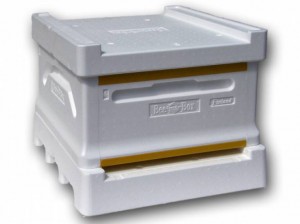 For many years now, some beekeepers have been using hives made from polystyrene. The compound is lightweight, rigid, and is a pretty good insulator – all good things for a hive. But it’s styrofoam. The stuff that the crappy little coffee cups and the containers from McDonald’s food comes in. The stuff that won’t biodegrade. The stuff that’s made from petrochemicals – yeah, sludge from the bottom of oil barrels. I’m sure I’d be thrilled to live in a home made of it…
For many years now, some beekeepers have been using hives made from polystyrene. The compound is lightweight, rigid, and is a pretty good insulator – all good things for a hive. But it’s styrofoam. The stuff that the crappy little coffee cups and the containers from McDonald’s food comes in. The stuff that won’t biodegrade. The stuff that’s made from petrochemicals – yeah, sludge from the bottom of oil barrels. I’m sure I’d be thrilled to live in a home made of it…
Now I’m an “organic beekeeper”. Whatever that officially means I don’t know, but to me it means doing everything I can to keep human-made products away from the hive. Now let me be clear, I use wooden hives and parts that are made by humans, so I’m not that hard core. I use a metal hive tool, and I’m quite sure my bee jacket isn’t 100% cotton, but I try hard to make sure that my bees aren’t exposed to more chemicals than they have to be, so I focus on keeping the hive all wooden, with a little steel (nails and screen) where needed.
So when I read about polystyrene hives, and the inevitable trouble beekeepers have with them, I am just shocked that they still exist. Somewhere in my semi-logical mind I would have thought they would have faded out like a bad fashion trend. Something that beekeepers could look back on and say “Remember when we used those polystyrene hives? Yeah, what were we thinking? {laughter}…”
If you’re thinking of getting into beekeeping, please start with wood and not plastic. If you’re afraid of deforestation, buy scrap wood – mostly it’s free. I’ve build all of my additional hive parts out of scrap wood. Their cheap to make, and didn’t hurt the environment. Plastic is just so… Yuck.
Wood is natural, and the bees love it. I mean, it’s wood – what’s not to love?

